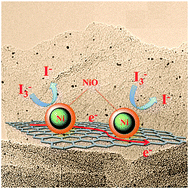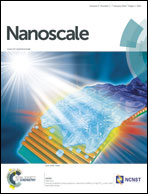Graphene–NiO nanohybrid prepared by dry plasma reduction as a low-cost counter electrode material for dye-sensitized solar cells†
Abstract
NiO nanoparticles (NPs) were hybridized on the surface of reduced graphene oxide (RGO) by dry plasma reduction (DPR) at atmospheric pressure without any toxic chemicals and at a low temperature. NiO-NPs of 0.5–3 nm size, with a typical size of 1.5 nm, were uniformly hybridized on the surface of RGO. An XPS analysis and the Raman spectra also revealed the repair of some structural damage on the basal plane of the graphene. The material when applied to the counter electrode (CE) of dye-sensitized solar cells (DSCs) exhibited a power conversion efficiency of 7.42% (±0.10%), which is comparable to a conventional Pt-sputtered CE (8.18% (±0.08%)). This material outperformed CEs produced using NiO-NPs (1.53% (±0.15%)), GO (4.48% (±0.12%)) and RGO (5.18% (±0.11)) due to its high electrochemical catalytic activity and high conductivity. The charge transfer resistance for NiO-NP–RGO was as low as 1.93 Ω cm2, while those of a NiO-NP-immobilized electrode and a GO-coated electrode were 44.39 Ω cm2 and 12.19 Ω cm2, respectively, due to a synergistic effect.


 Please wait while we load your content...
Please wait while we load your content...